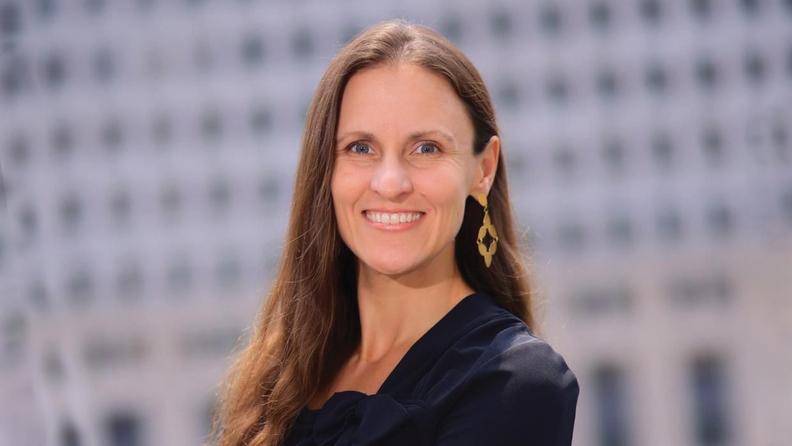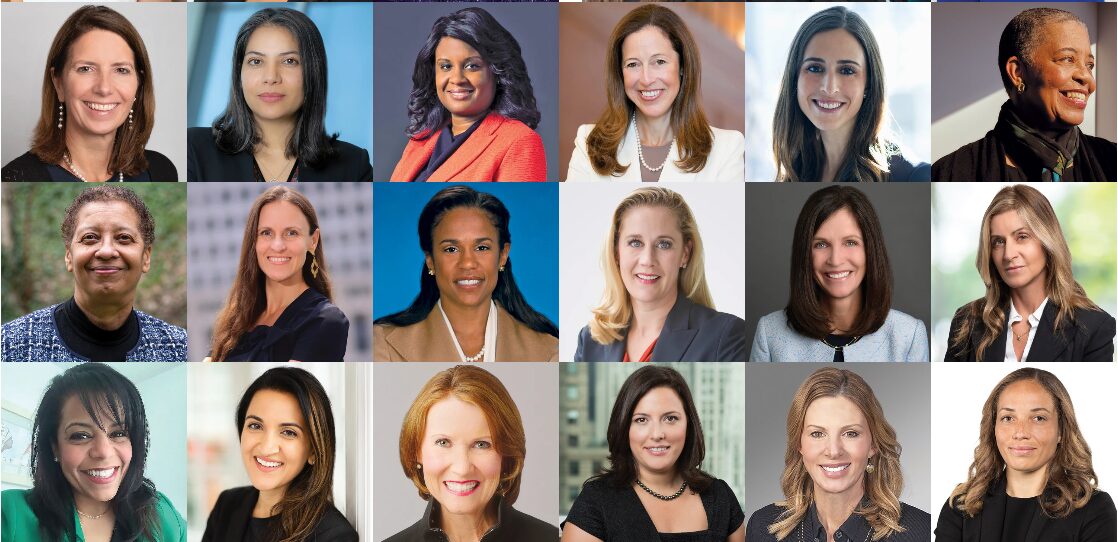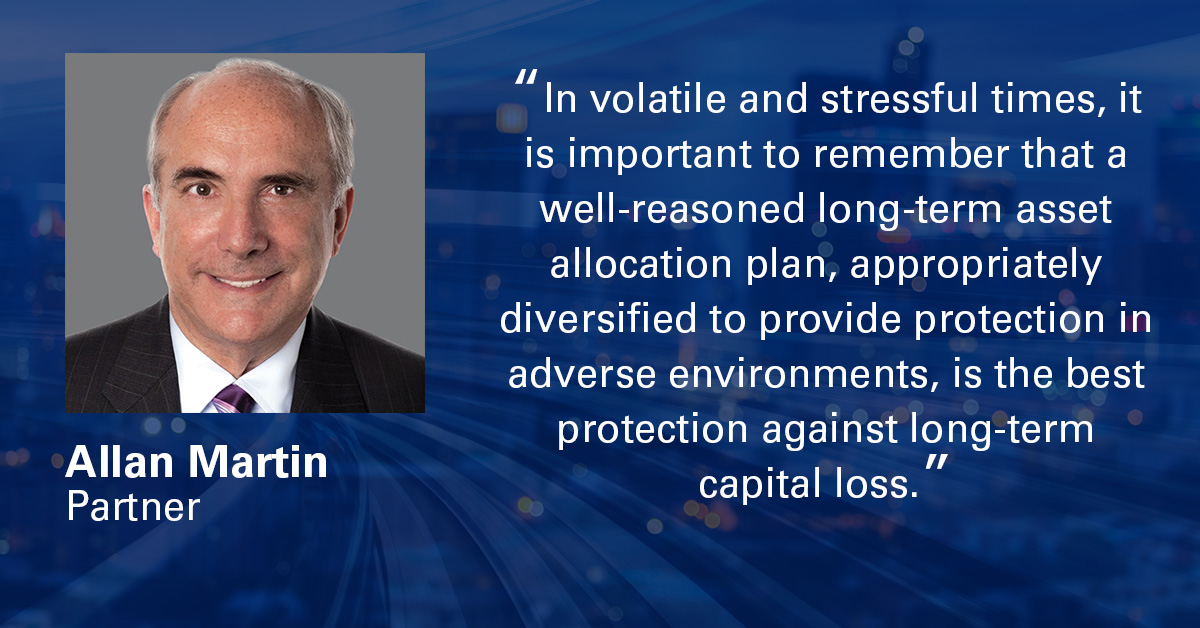FundFire: Small Endowments to Outperform Large Peers in FY23, Consultants Say
NEPC’s Kristin Reynolds was quoted in a recent FundFire article to discuss the impact that the lag in private equity valuations and venture capital returns will have on endowments this year. View the article on FundFire’s site here.
As universities begin to release their year-end results, investment consultants and outsourced chief investment officers expect small endowments to post better returns than their large counterparts.
. . .
The poor venture capital returns are due to a lag in valuations, the same delay that caused them to outperform public equities in 2022. Now, private equity’s valuation lag has hurt the overall value of the asset class in the year-end results, while public equities posted strong results, NEPC Partner and Practice Group Director Kristin Reynolds said.
“I expect that endowments with higher levels of private markets will trail those with higher levels of public markets by a pretty large margin,” she said.
Read the full article on FundFire’s website here.
FOX Business: Chevron CEO: Oil Will Break $100 per Barrel 'Soon'
NEPC’s Jennifer Appel was quoted in a recent FOX Business article which focuses on how rising crude prices could create a new inflation headwind. View the article on FOX Business’ site here.
Chevron CEO Mike Wirth told Bloomberg that the price of oil “probably is headed for the $100 mark soon amid tightening supplies.”
Production reductions from Russia and Saudia Arabia have West Texas Intermediate (WTI) trading above $90 per barrel, while the global benchmark Brent Crude is hovering at $94 per barrel.
. . .
“Higher energy prices have a significant impact on headline CPI, and we expect these pressures to flow through to other aspects of inflation in the coming months,” Senior Investment Director of Asset Allocation at NEPC Jennifer Appel told FOX Business. “A sustained uptick in inflation resulting from gasoline prices will complicate the Fed’s efforts to curb inflation and may introduce an upward bias into interest rate expectations.” The Federal Reserve will announce its decision on interest rates Wednesday at 2 p.m. ET.
Click here to continue reading the full FOX Business article.
Pensions & Investments: Sarah Samuels Named to Influential Women in Institutional Investing List
Congratulations to Sarah Samuels, CFA, CAIA, Partner at NEPC, on her inclusion in the inaugural class of Pensions & Investments Influential Women in Institutional Investing. Read more about how Sarah’s non-traditional background has driven her desire to help others rise up in the industry: View the article on Pensions & Investments’ site here.
Despite being in the industry for 19 years, Sarah Samuels said she had a “non-traditional career path.”
After graduating college as a German major with no industry internship experience, she started out as an administrative assistant at Wellington Management Co. She worked her way through several roles and companies before becoming a partner at NEPC LLC in 2019. In her current role, she leads a 45-person investment manager research team representing $1.5 trillion in assets under advisement and management.
. . .
“Extremely hard work” was another factor to her success, she said. “I was told no many, many times for different roles or requests,” so “tenacity was important.”
Ms. Samuels said her non-traditional background is what drives her desire to help others rise up in the industry.
As a member of TBD Angels, Ms. Samuels invests in early stage ventures to help them grow. “For me, I have a focus on diverse founders, or organizations that have missions to improve diversity or social equity in our world,” she said.
Click here to read Sarah’s full Pensions & Investments profile.
Pensions & Investments: Need Career Advice? Here’s Hard-Won Wisdom
The inaugural class of Pensions & Investments Influential Women in Institutional Investing shared career advice they’d give to their younger selves. Our very own, Head of Investment Manager Research, Sarah Samuels, explains what she calls “30 seconds of bravery.”: View the article on Pensions & Investments’ site here.
P&I’s inaugural class of Influential Women in Institutional Investing shared what advice they’d give to their younger self, if they could go back in time.
What follows are some of the top answers:
. . .
Sarah Samuels, NEPC, is a big believer in what she calls “30 seconds of bravery,” which she learned about nearly a decade into her career. “If there’s something that you’d like to do, but you’re too scared to do it — think about asking for a promotion, asking for a raise. So it’s something big in your personal life even, that it makes you sweat to think about doing it… Just do it for 30 seconds. It can hurt that bad. Only so much pain can happen in 30 seconds if you do that hard thing. And I promise you it’ll change your life.”
Chief Investment Officer: Bill Ryan Named to 2023 Knowledge Brokers List
Congratulations to Bill Ryan, Partner & Head of Defined Contribution Solutions at NEPC, on being named to CIO’s 2023 Knowledge Brokers list. Read an excerpt from his Q&A session with CIO below, or view the full interview on Chief Investment Officer’s site here.
As a Partner at NEPC, an independent investment consultant, private wealth adviser, and outsourced chief investment officer provider, Bill Ryan leads the firm’s Defined Contribution (DC) Practice as the Head of DC Solutions. His role is to oversee more than 140 DC clients NEPC serves. Ryan helps plan sponsors address today’s increasingly complicated challenges, from governance model support and operational risk management, to using plan data more effectively to inform plan design.
. . .
CIO: What do you think will be the biggest innovation in your industry in the next 10 years?
Ryan: “Like so many industries, generative artificial intelligence (GAI) will transform our industry in the years to come. While the technology has existed for some time, tools like Chat GPT are now being embraced to help streamline day-to-day processes and allow for more brainstorming and collaboration on strategic problem-solving.
For example, the use of GAI within DC plan investment solutions will allow for the more traditional static implementation of asset allocation via a target-date fund to become dynamic and truly personalized through its self-learning. This will in turn provide new actionable communication channels between consultants and plan sponsors and, potentially allowing them to address nuances around a participant’s investment objectives directly. In my view, it will be crucial to outline exactly how these tools can and should be used, particularly given the heavy regulation of our industry.”
CIO: What investments (specific securities or sectors) look good to you now? And why?
Ryan: “Looking at the current market and factoring in the Federal Reserve continuing to hike interest rates, we’re working with clients to focus on opportunistic asset classes that have been heavily affected by changes in interest rates, such as fixed income and insurance products. After more than a decade of discount rates being nonexistent, we are seeing the value of income-yielding investments as well as fixed annuities increasing as participants can now get a true future value for a dollar invested today, compared to the past 10 years when rates were nearly zero.”
Chief Investment Officer: Allan Martin Named to 2023 Knowledge Brokers List
Congratulations to Allan Martin, Partner at NEPC, on being named to CIO’s 2023 Knowledge Brokers list. Read an excerpt from his Q&A session with CIO below, or view the full interview on Chief Investment Officer’s site here.
Allan C. Martin joined NEPC in 2000. In 2018, he was named a Chief Investment Officer Knowledge Broker and at the CIO Industry Innovation Awards, he was named Consultant of the Year. He currently advises six large public pension funds.
. . .
CIO: What changes are you making to your asset allocation advice given the current state of monetary policy in a post-COVID, deglobalizing world and considering the impact of inflation and rising interest rates?
Martin: “Investors experienced a paradigm shift in 2022, as central banks transitioned from supporting economic growth to combating inflation. This paradigm shift will reset the expectations for investors, capital markets, economies, consumers and corporations across the globe. This transition is forcing a broad re-pricing across all financial assets, and higher discount rates are likely to challenge the capital market structures that thrived over the last decade. The 40-year interest rate super cycle has ended, and capital markets are only beginning to reflect an environment of higher discount rates and an increased cost of capital. With this regime shift, we are focused on the implications of three core themes:
- Tight Monetary Policy and High Discount Rates: We are encouraging the adoption of more defensive asset allocation structures, adding greater exposure to equities, public and private, embracing the risk-return benefits of higher contractual income, public and especially private, and dedicated allocations to Treasurys and other defensive assets.
- Importance of Real Returns: Nominal returns have been the primary consideration of the last 10 years, and this is likely to change over the next decade. To this end, we are looking to identify high-carry assets to add to portfolios while also considering the use of inflation-sensitive assets.
- Disruption to Portfolio Construction: Rising interest rates and sticky inflation levels disrupt traditional asset allocation structures, and we encourage investors to explore the use of diversifying assets to hold greater liquidity and to review strategic policy targets for portfolios.”
CIO: What macro themes will drive the most volatility for institutional investors over the next 10 years?
Martin: “The likely answer to this question is a new theme or risk that is outside of the traditional consensus and will represent a surprise relative to current market views. An investor in 2005 would not have anticipated that cash rates would sit near 0% for a decade plus. The same is true today: We have been accustomed to a low interest rate environment, and Treasury rates above 6% are viewed as very unlikely. The post-World War II era has been dominated by a period of multinational negation and removal of trade barriers, leading to an unprecedented growth in international trade. Unfortunately, the concomitant growth in world GDP over this period has not been distributed evenly across income levels, leading to the current state of political polarization, which has the potential to stall or disrupt global trade and foster the reemergence of nationalism. Part of this theme to consider in the nearer term is China’s relationship with the U.S. Will the economic relationship be dependent on economic competition or economic conflict? The path of this trend has global implications for inflation and economic productivity. Lastly, the trajectory of the U.S. dollar influences global financial stability, and the trajectory of Fed monetary policy relative to other central banks will heavily influence the strength of the U.S. dollar. In the longer term, the world’s population is aging, and productivity continues to rise, so the norm of wealth distribution based on work performed will be challenged, with significant implications for the return to capital.”
PlanSponsor: Plan Sponsors Increasingly Add Focus on Post-Retirement Strategy
NEPC’s Emma O’Brien was quoted in a recent PlanSponsor article to discuss how plan sponsors can help ‘demystify’ the overall process for participants. View the article on PlanSponsor’s site here.
A new education push is underway among plan sponsors, who are looking to help employees create income in retirement when their last day of work precedes eligibility for Medicare and Social Security benefits.
. . .
Starting conversations about these topics early is key to overcoming inertia and to demystifying the process, according to Emma O’Brien, a senior consultant with NEPC who is based in the Boston area. A consultant to plan sponsors, she sees greater success in easing stress among employees when plan sponsors engage their participants long before they have a retirement date in mind. Varied direct messaging is essential too, as she recommends multiple attempts to reach employees, whether by email or by mail.
“It starts with making sure that the plan is simple and clear to participants so that when they do engage, they don’t get overwhelmed,” O’Brien says.
Finding ways to encourage employees to boost savings is a necessary complement to getting employees involved with their retirement plans, she says.
“The more participants contribute as active employees, the more options they have for spending down their benefits in retirement, both in terms of the dollar amounts they can draw, as well as the different distribution strategies,” O’Brien says.
. . .
She also sees benefits in providing modeling, such as when recordkeepers provide tools within their websites to help participants forecast their potential savings at retirement. Some include the ability to incorporate Social Security benefits as well, O’Brien says. Gaming out different options can quickly show pros and cons.
. . .
O’Brien too, sees how employees are aided by testing various scenarios. “They can model out what their future Social Security benefit is, and that’s the way to get a much more personalized approach,” she says.
She also encourages plan sponsors to reframe how they discuss Social Security with plan participants.
“We’re changing the way we think about Social Security, which is essentially an annuity,” O’Brien says. “Providing participants with information and tools to understand what their income replacement can be in retirement through their DC savings and Social Security benefits is really useful education.”
Read the full article on Plan Sponsor’s website here.
FundFire: China is Hot Topic Among Consultants as Political Pressure Grows
NEPC’s Jennifer Appel was quoted in a recent FundFire article noting that future policies from China and the U.S. will pose the most risk to private markets. View the article on FundFire’s site here.
Investment consultants that began the year bullish on China are reassessing the role it should play in institutional investors’ portfolios, as political tensions between the U.S. and China escalate.
Some consultants are recommending active management as the best way to invest in emerging markets and others are warning against private equity in China.
. . .
NEPC largely remains bullish on investments in China but said that private markets will be the riskiest investments currently.
Biden’s executive order targeted specific private market investments in China which are unlikely to affect any institutional investors commitments in China. However, future policies from China and the U.S. will likely attack the private market sector, making these commitments the riskiest, NEPC Senior Investment Director Jennifer Appel said in a paper written this month for the firm.
“China’s central government has restricted private investment in some sectors for policy reasons, for instance, online tutoring and video games; we expect policy risk to persist, and investors must be mindful of unexpected policy changes, which can impact sectors without warning,” she wrote.
Read the full article on FundFire’s website here.
FundFire: Hedge Funds Bolster Moves into Real Estate
NEPC’s Dulari Pancholi was quoted in a recent FundFire article highlighting an upward trend in hedge funds moving into the real estate space over the past decade.
Big hedge funds that have planted a flag in the real estate asset class appear to be thriving in their adopted markets with new vintages and fundraising efforts – an example of diversification that more of their peer managers might emulate as a way to tap potential growth.
. . .
Extending into real estate can be beneficial to hedge funds, said Dulari Pancholi, a partner leading the credit and multi-asset teams at NEPC.
“Over the past few years, hedge funds have gone through their own struggles,” she said. “If they’re able to build a differentiated business that is a longer-dated product, it locks in a revenue stream that is different and not reliant on just the hedge fund model [where] assets can ebb and flow. So, that brings a little stability to the firm.”
There has been an “upward trend” of hedge funds developing real estate arms over the last decade, especially targeting credit and distress-driven strategies, Pancholi added.
Read the full article on FundFire’s website here.
FIN News: Q2 2023: Private Infrastructure Offerings Gain Steam, Contribute To Hire Uptick
NEPC’s Matthew Ritter was recently featured in FIN News’ Q2 hiring analysis report. View the full article on FIN News’ site here.
Institutional commitments to private infrastructure funds increased in the second quarter given attractive characteristics—like providing an inflation hedge or cash yield—and product offerings that have gained steam in recent years, a trend that will likely continue into the second half of 2023 and beyond.
. . .
“While private market budgets have been somewhat muted in 2023, investment consultant NEPC expects to see continued growth and interest in infrastructure investing.
“Those mandates or those new commitments follow a trend in recent years of more and more investors adding infrastructure as a target allocation in their overall portfolio,” NEPC Partner Matthew Ritter said.
NEPC’s Quarterly Asset Class Review for the second quarter found that the Standard & Poor’s Global Infrastructure Index, which tracks 75 companies globally across the listed infrastructure space within a sector breakdown that includes utilities, industrials and energy, was “flat” for the quarter at -0.1%.
However, NEPC noted that it “continues to “favor private markets when it comes to implementing infrastructure in a portfolio.””
. . .
“NEPC’s Ritter, who heads the Boston-based firm’s Real Assets Investments Team, has also noticed growth in infrastructure strategies in recent years.
“That growth is continuing and perhaps more importantly, this space has evolved quite a bit and so infrastructure today offers investors a much wider array of strategies than was available even just a few years ago. There may be attractive investment opportunities regardless of what an investor’s return objectives or risk appetite might be,” he said.”
. . .
“NEPC finds there are attractive opportunities in the more thematic areas of infrastructure such as digital and communications.
“Some of the themes that we are focused on are segments of the infrastructure market that have very strong and resilient demand tailwinds, so more specifically that would be things like digital infrastructure and capitalizing on the continued growth of data consumption and transmission globally, as well as energy transition themes. So, not just renewable power generation but also all the ancillary assets, infrastructure services, that come along with that, whether it’s improving electricity transmission [or] grade upgrades,” Ritter said.”
. . .
“Ritter, who has been with NEPC for over 11 years covering real asset investments, indicated that at a high level, infrastructure can provide a lot of benefits to a portfolio like current income, diversification, but it is also reflective of what else is going on in client portfolios.
“More specifically for some clients, you’re seeing infrastructure as an alternative to more traditional oil and gas strategies that may have previously made up a real asset allocation. Across private markets, there may be some more uncertainty in places like real estate or some private equity strategies that [we] think infrastructure is seeing the benefits of,” he said.
“Infrastructure can provide diversification benefits just by the nature of having demand drivers and cash flow that is generally not correlated to things like GDP growth, and that results in generally low correlation to traditional stock and bond-types of investment opportunities,” Ritter continued.”









